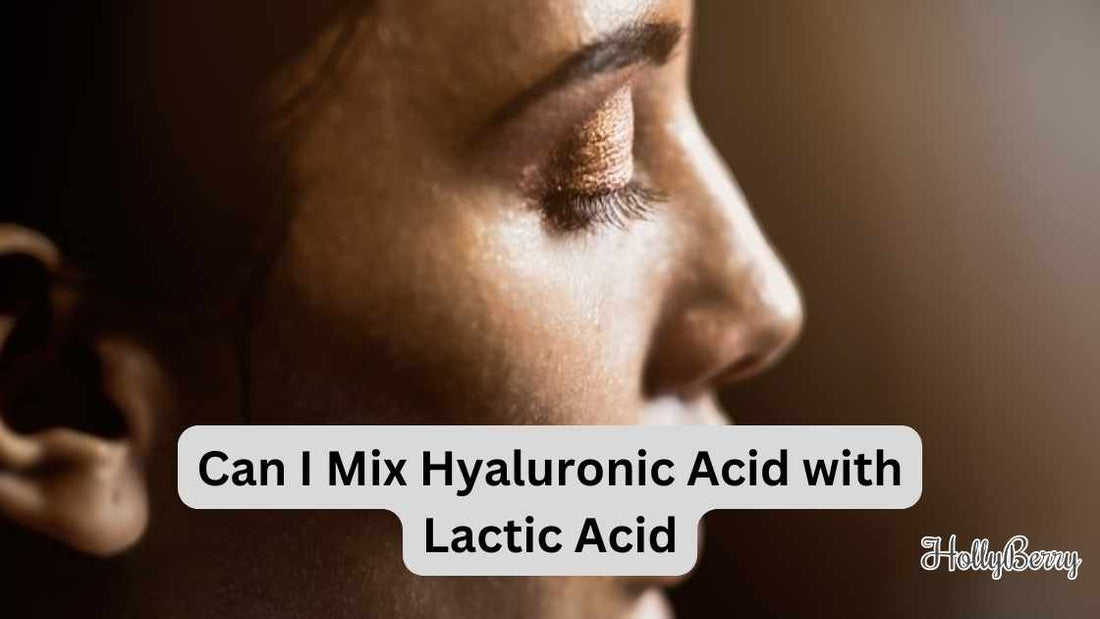
Can I Mix Hyaluronic Acid with Lactic Acid
Share
Combining Skincare Ingredients Safely

Hyaluronic acid and lactic acid are two widely celebrated skincare ingredients, each acclaimed for distinctive benefits.
Hyaluronic acid is renowned for its exceptional hydrating properties, drawing moisture into the skin and helping to maintain plumpness and hydration.
It is a gentle ingredient that suits all skin types, which makes it a versatile addition to any skincare routine.
Lactic acid, on the other hand, is an alpha hydroxy acid (AHA) known for its exfoliating abilities. It works by loosening the bonds between dead skin cells on the epidermis, promoting a smoother skin texture and a more radiant complexion.
While acids in skincare may sound alarming, lactic acid is considered among the milder exfoliants and is suitable for a wide range of skin types, including those that are more sensitive.
When it comes to mixing these two ingredients, they can indeed be used together effectively. The exfoliating action of lactic acid allows for better penetration of hyaluronic acid, enhancing the skin’s hydration and overall texture.
Furthermore, since lactic acid can stimulate the skin's natural hyaluronic acid production, pairing it with a hyaluronic acid product amplifies the moisturizing benefits.
It is always advised to perform a patch test before trying new product combinations and to introduce acids gradually to the skincare routine to minimise the risk of irritation.
Comprehensive Overview of Combining Hyaluronic and Lactic Acids
Combining hyaluronic acid and lactic acid in a skincare routine potentially offers several benefits to the skin, provided the products are applied correctly and considering any potential skin sensitivities.

Shop in our UK store for Hyaluronic Acid
Benefits and Effects on the Skin
Hyaluronic acid is a powerful humectant that attracts moisture, capable of holding up to 1000 times its weight in water.
This ingredient primarily functions to hydrate the skin, leading to a plumper appearance which can reduce the visibility of fine lines and wrinkles. Lactic acid, an alpha hydroxy acid (AHA), gently exfoliates the skin's surface, promoting cell turnover and improving skin texture.
-
Hyaluronic Acid:
- Hydrates the skin
- Reduces appearance of fine lines
-
Lactic Acid:
- Exfoliates and smoothens skin
- Can brighten the complexion
Using these acids together can synergistically enhance skin hydration and exfoliation without over-drying or irritation in most skin types, including sensitive skin.
Optimal Application and Layering Techniques
When incorporating both hyaluronic acid and lactic acid into a skincare regimen, the order of application is important to maximise effectiveness:
- Cleanse: Use a gentle cleanser to prepare the skin for treatment.
- Lactic Acid: Apply lactic acid product, which may come in the form of a serum or toner. Allow it to absorb fully.
- Hyaluronic Acid: Follow with a hyaluronic acid serum, ensuring the skin is slightly damp to help lock in moisture.
- Moisturize: Finish with a moisturiser to seal in the ingredients and provide additional hydration.
Layering in this sequence ensures exfoliation occurs first, followed by deep hydration.
Potential Risks and Considerations
While the combination of hyaluronic and lactic acids can be beneficial, it's important to note potential risks:
- Sensitivity: Individuals with extremely sensitive skin may experience irritation or redness. Patch testing is recommended.
- Overuse: Excessive use of AHAs like lactic acid can irritate or dry out the skin, especially when not properly moisturized.
Consultation with a dermatologist is advised for those with sensitive skin or when starting a new skincare regimen involving active ingredients.
Incorporating Other Skincare Components
Incorporating hyaluronic acid with lactic acid in a skincare routine necessitates understanding how other skincare components can synergise or conflict with this combination.
Synergistic Ingredients and Products
When combining hyaluronic acid with lactic acid, one may consider including ingredients that support hydration, such as glycerin or ceramides. These help reinforce the skin's natural barrier and prevent moisture loss.
Antioxidants like vitamin C and niacinamide can be beneficial as well, providing protection against signs of ageing and pollution-induced free radicals. Here is a list of compatible ingredients to layer with hyaluronic and lactic acid:
- Vitamin C: Helps to brighten the skin and can be used during the morning routine.
- Niacinamide: Known for its soothing properties and improving skin texture.
- Peptides: Aid in skin repair and rejuvenation.
- Sunscreen: Essential to protect against UV-induced damage when using exfoliating acids.
Avoiding Conflicting Skincare Ingredients
Certain active ingredients may conflict with the use of lactic acid and hyaluronic acid. For instance, it is generally recommended to avoid mixing strong retinoids or retinol with acids in the same application due to increased potential for irritation.
The same holds true for other potent exfoliants like glycolic and salicylic acid or acne treatments containing benzoyl peroxide.
It's prudent to schedule these components separately within a skincare routine — perhaps retinoids at night and acids in the morning — and always include sunscreen to safeguard against heightened photosensitivity. Here's a brief outline of ingredients to avoid combining in immediate succession:
- Retinoids/Retinol: To prevent irritation, use separately from acids.
- Benzoyl Peroxide: Can deactivate certain ingredients like vitamin C; use at different times.
- Excessive Exfoliants: Over-exfoliation can lead to skin sensitivity; moderate use.
